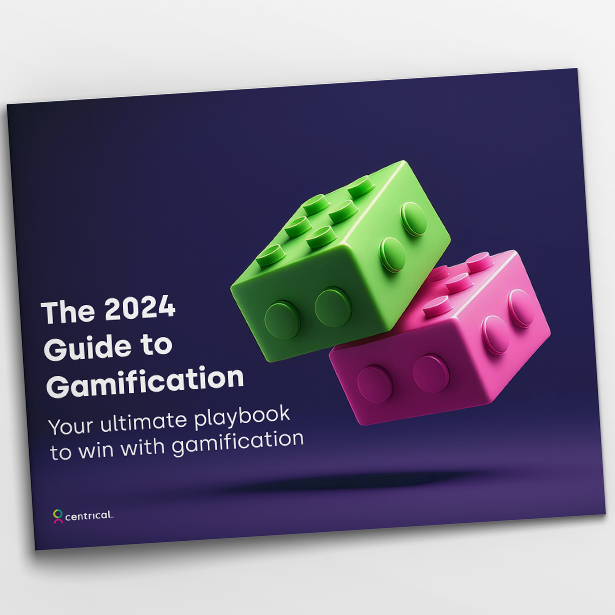Inside the Mechanics of Gamified Storytelling
Gamification is still a relatively misunderstood and poorly executed craft. For most people, it’s the application of points, badges, and leader boards (PBLs), as they are the most common and most straightforward game mechanics to apply.
Because of this, it often results in initial engagement, a few quick lifts in performance, and excitement for some employees. However, in my experience, it is rarely sustained due to these common oversights:
- Balancing – It can be hard to balance the increasing difficulty, particularly if it is not dynamically balancing, leaving people either bored or overwhelmed.
- Meaningful Badging – Ensuring that digital badges effectively represent the effort to earn them. Achieving a badge for showing up to work or doing rudimentary tasks does not fill most people with pride and, in many cases, has an adverse effect, leaving people feeling like the badges are more condescending than complimentary.
- Not Considering the Behaviors – When implemented thoughtfully, points and leader boards can drive undesired behaviors, often quickly observed when simply slapped on KPIs.
That said, there are sustainable, effective ways to implement these game mechanics so that badges are meaningful and leader boards create an iron-sharpens-iron culture.
There are plenty of articles and research on this exact aspect of gamification, so instead, I wanted to explore one game mechanic that is often overlooked, under-utilized, and perhaps not even recognized as a game mechanic… storytelling.
The Power of a Good Story
Storytelling is a powerful tool we humans have used to share knowledge and culture since the dawn of time. Indigenous Australians (the world’s oldest continuous culture) have used storytelling that dates back 60,000 years! Used to pass on survival tips and cultural beliefs and record information such as sea levels over the past 7,000 years!
Gamification, on the other hand, has not been around that long, yet stories play a vital role in its success. Storytelling, in the much younger world of gamification, does one thing well. It asks a simple question. What’s next?
You see, one thing points badges and leader boards fail to do as effectively is create a reason for people to return (to whatever you are driving) consistently. They are not good at creating space for curiosity, which is a great attribute to have in employees. Why is curiosity great? Well, it’s linked to many benefits:
- Curious people tend to be happier and
- Experience increased personal growth
- Curiosity increases team bonding
- Curiosity helps build resilience, increases adaptability, and releases dopamine in our brains to reward learning
PBLs can be great motivators when implemented correctly, but they don’t necessarily anchor someone to an intrinsic why.
“The past beats inside me like a second heart.”― John Banville
As humans, we are constantly looking for a reason to make a connection. Storytelling is a fantastic tool for helping to form connections. It helps organize how we store and categorize information in our brain by creating stronger neural connections. It does this because, unlike raw data, stories have emotion, flavor, structure (beginning, middle, and end), and surprise (plot twists and conflict), making them more memorable.
I was lucky enough to attend a workshop by Daniel Kilov, a Mental Athlete (yes, it’s a thing). He impressed us by memorizing a shuffled deck of cards in just a few minutes. In his workshop, he taught the other participants and me how to remember 50 random items. At the beginning of the challenge, we were given a list of 50 things to remember, and most of us sat there repeating them over and over again in the hopes that repetition would be the key. Most of us were lucky if we could recall much past the early teens at best. However, Daniel taught us a technique using a combination of special awareness and, you guessed it, storytelling. Suddenly I could recall 50 random objects with little effort within a very short time. This skill became quite valuable when I had to memorize 240 employee names in a week.
Long story, storytelling is great for memory recall.
—
So, storytelling drives curiosity, which has many positive benefits, and it also forges mental, neurological, and personal connections, which is great for engagement, a sense of achievement, and belonging.
For gamification to be great, it needs to be sustainable, effective, and engaging. Nothing ticks all those criteria better than a good old-fashioned story.
So, suppose gamification has piqued your curiosity. In that case, you may want first to consider the story you want to pair with your more traditional game mechanics.
The only question now is… What’s next?

About the Author: Luke Jamieson is the Global Content Director at Centrical and one of the top 25 global influencers and thought leaders on customer experience and employee engagement. His rebellious, unconventional approaches have been attributed to him earning such titles. But it is his combination of vision, high energy, audacious creativity, and mischievous execution that makes him an inspiring and refreshing speaker, podcaster, and blogger.
Engage and motivate your frontline teams
Improve performance with an AI-powered digital coach
Deliver world class CX with dynamic, actionable quality evaluations
Boost performance with personalized, actionable goals
Nurture employee success with the power of AI
Listen and respond to your frontline, continuously
Drive productivity with performance-driven learning that sticks
Drive agent efficiency, deliver client results
Keep tech teams motivated and proficient on products and services while exceeding targets
Maintain compliance while building customer happiness and loyalty
Enlighten energy teams to boost engagement
Engage, develop, and retain your agents while driving better CX
Improve the employee experience for your reservations and service desk agents









 Dalit Sadeh
Dalit Sadeh April Crichlow
April Crichlow Ella Davidson
Ella Davidson Linat Mart
Linat Mart Gal Rimon
Gal Rimon Jayme Smithers
Jayme Smithers Doron Neumann
Doron Neumann Daphne Saragosti
Daphne Saragosti Ronen Botzer
Ronen Botzer Ariel Herman
Ariel Herman